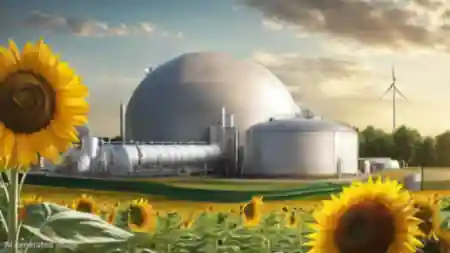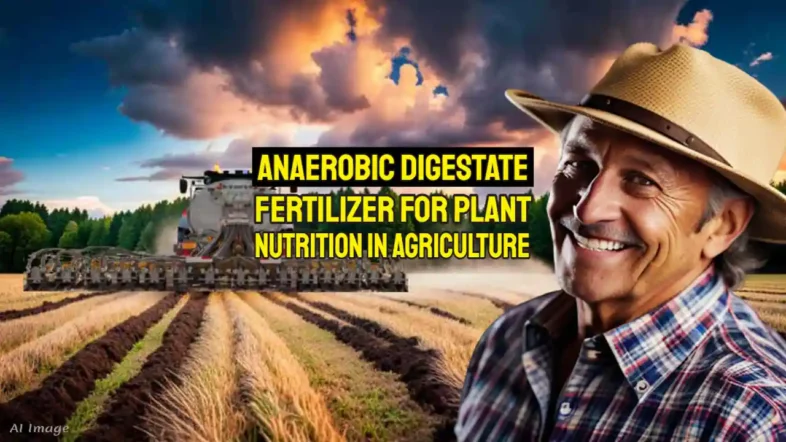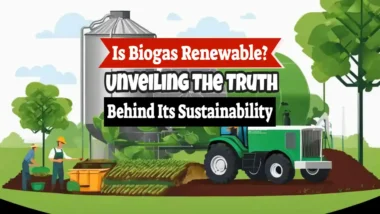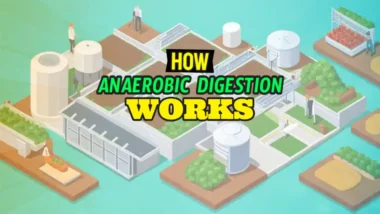Anaerobic digestate fertilizer can be an important source of the essential elements of plant nutrition in agriculture. To put it simply: The sustainable renewable fertilizer made from the leftovers of the “decomposition process that doesn't use oxygen” can be a key source of the vital nutrients plants need to grow in farming.
For the agricultural community understanding the nutritional needs of crops is fundamental for:
- maximizing yield and
- promoting sustainable farming practices.
This article delves into the crucial plant food elements, types of fertilizers, and their application, alongside the benefits of organic materials and the environmental considerations tied to fertilizer use.
[boomdevs_toc]
Main Plant Food Elements Required by Crops
Major Nutrients
Crops require a range of nutrients for optimal growth, categorized into major nutrients and micronutrients:
- Nitrogen (N): Vital for leaf growth and green colour.
- Phosphorus (P): Supports root development and flowering.
- Potassium (K): Enhances overall plant health and disease resistance.
Micronutrients (Trace Elements)
Micronutrients, though needed in smaller quantities, are essential for various physiological functions:
- Examples include Iron (Fe), Zinc (Zn), Manganese (Mn), Copper (Cu), and Molybdenum (Mo).
Digestate contains all the requirements above.

Fertilizer Materials Used On-Farm
Understanding Chemical Fertilizer Types
- Straights: Provide a single nutrient, e.g., urea for nitrogen.
- Compounds: Contain a combination of nutrients in each particle.
- Complexes: Nutrients chemically bound together, offering a controlled release.
- Blends: Physical mixtures of different fertilizers to achieve a desired nutrient ratio.
Anaerobic digestate fertilizer does not neatly comply with any of these categories so at some time in the future it will probably be added as a new category.
Some AD plant operators are drying their digestate.
Application Practices and Methods
- Solid Fertilizers: Applied using broadcast spreaders or localized placement techniques.
- Liquid Fertilizers: Delivered through irrigation systems or foliar sprays for efficient absorption.
Once again, anaerobic digestate fertilizer as it leaves the digester, is neither of these because it is a slurry containing solid fibres and a liquid. The liquid may be irrigated, as above, but when applied to the fields as a liquid, best practice suggests that it be injected into the soil, for the lowest odour impact.
Organic Materials as Valuable Nutrient Sources and Soil Conditioners
Organic materials from on-farm and off-farm sources are praised not just for their nutrient content but also for their role in soil conditioning. These include:
- Composted vegetable matter
- Animal manures
- Green manures
- Digestate – if the farm operates a biogas plant or has an anaerobic digestate fertilizer supply.
Chemical fertilizers, on the other hand, provide negligible soil conditioning.
The Role of Livestock Manures and Slurries
 Livestock manures and slurries are rich in nutrients and organic matter, making them excellent for improving soil fertility and structure when applied correctly, considering their nutrient content but not ideal when considering the potential for pathogen transfer.
Livestock manures and slurries are rich in nutrients and organic matter, making them excellent for improving soil fertility and structure when applied correctly, considering their nutrient content but not ideal when considering the potential for pathogen transfer.
However, when directly applied to the fields, livestock manures and slurries cause extensive watercourse pollution due to high water nutrient levels which leads to algal blooms and reduced dissolved oxygen levels.
However, if the anaerobic digestion process is used on these wastes the output after energy extraction (for biogas):
- the potential for pathogen transfer is much lower, and yet the potential for improving soil fertility and structure is undiminished
- odour during spreading and after is diminished
- nitrogen crop availability is better than for untreated manure meaning lower pollution potential for digestate vs manure.
There is a negative for anaerobic digestate fertilizer though as the nitrogen level is high and that must be managed by limiting the amount spread and keeping accurate records of spreading locations.
Digestate from Anaerobic Digestion
Digestate, a byproduct of the biogas production process, serves as a potent fertilizer offering a unique opportunity to create a renewable natural fertiliser.
Digestate Definition
Digestate is a nutrient-rich material formed during anaerobic digestion that can be utilised as a fertiliser. It is made up of leftover indigestible material and dead microorganisms; the volume of digestate will be approximately 90-95% of what was fed into the digester.
It's particularly suitable for use in situations where soil improvement and sustainable nutrient recycling are prioritized.

Why Fertilisers are Vitally Important
Fertilisers play a crucial role in supporting global food security by replenishing soil nutrients, which are essential for plant growth and agricultural productivity. This impact is felt at various levels, from local to global food systems.
- Food Security: Fertilisers directly influence food production, enabling higher crop yields and more reliable food supplies. By providing essential nutrients like nitrogen, phosphorus, and potassium, fertilisers enhance the growth and development of plants, which form the basis of the food chain.
- UK National Food Security: In the UK, the reliance on imported artificial fertilisers is significant for domestic crop production. This reliance is due to the country's need to maintain high agricultural productivity levels to support its population. The effective use of fertilisers ensures that the UK can achieve food security, despite challenges such as limited arable land and varying climate conditions.
- International Food Security: On an international level, fertilisers facilitate the global trade of agricultural products by boosting crop production in exporting countries. This is crucial for countries that depend on food imports to meet their population's needs. The role of fertilisers in international food security is also pivotal in emergency food aid and in supporting developing countries' agricultural sectors.
- UK Reliance on Imported Artificial Fertilisers for Domestic Crop Production: The UK's dependency on imported fertilisers highlights the interconnectedness of global supply chains and the importance of stable international markets for agricultural inputs. Artificial fertilisers, often sourced from abroad, are integral to maintaining the productivity of UK farmland. This reliance underscores the need for strategic planning and policies to ensure a steady supply of these essential inputs, considering potential geopolitical and economic fluctuations that could impact availability and prices.
The importance of fertilisers extends beyond immediate agricultural needs, influencing economic stability, environmental sustainability, and long-term food security strategies.
As the UK and other nations navigate the complexities of reducing the environmental impact of global food systems, the role of anaerobic digestate fertilizer remains a key element in achieving a balance between meeting current food demands and preserving resources for future generations.
Utilizing Digestate in Agriculture: A Guide to Standards and Applications
Understanding Anaerobic Digestate Fertilizer Use
 It's crucial to plan the application to land of the resulting anaerobic digestate fertilizer by following good practice standards. This by-product can enrich agriculture, but its use can only be done legally in the UK if it aligns with specific quality standards, avoiding classification as “waste”.
It's crucial to plan the application to land of the resulting anaerobic digestate fertilizer by following good practice standards. This by-product can enrich agriculture, but its use can only be done legally in the UK if it aligns with specific quality standards, avoiding classification as “waste”.
Key Standards for Digestate Quality
- Quality Protocol and PAS110 (England & Wales): These outline the criteria for producing high-quality digestate from biowaste. Adherence transforms anaerobic digestate fertilizer from waste to a valuable bio-fertilizer.
- SEPA Position Statement (Scotland): Similar to PAS110, but tailored to Scottish regulations, ensuring digestate contributes to recycling goals under the Zero Waste Plan.
- Northern Ireland Regulatory Position Statement: Dictates digestate regulation, ensuring its safe and effective use in agriculture.
Certification and Assurance
The following is not a legal requirement, but such certification is increasingly becoming the norm:
- Biofertiliser Certification Scheme (BSC): Validates that anaerobic digestate fertilizer, referred to as biofertiliser, meets safety and quality benchmarks across the UK, promoting its use in sustainable farming practices.
Application Practices
 Digestate's application in agriculture hinges on meeting these standards, ensuring it serves as a nutrient-rich, environmentally friendly alternative to traditional fertilizers. Proper certification through schemes like the BSC assures farmers of digestate's benefits, both as a nutrient source and a soil conditioner.
Digestate's application in agriculture hinges on meeting these standards, ensuring it serves as a nutrient-rich, environmentally friendly alternative to traditional fertilizers. Proper certification through schemes like the BSC assures farmers of digestate's benefits, both as a nutrient source and a soil conditioner.
For detailed guidance on certification and the application of digestate in farming, the Biofertiliser Certification Scheme website offers comprehensive resources.
This framework ensures that anaerobic digestate fertilizer contributes positively to crop production and soil health, reinforcing the importance of sustainable agricultural practices in achieving environmental goals.
Impact on the Wider Environment
The application of all fertilizers and manures must be managed carefully to prevent nutrient runoff, which can lead to water pollution, eutrophication, and greenhouse gas emissions.
During the anaerobic digestion process, the nutrients in the feedstock are mineralized. Mineralized nutrients are easily absorbed by crops. According to academic studies, digestate solids have larger amounts of plant-available nitrogen and phosphate than as-excreted manure.
Hence, the impact on the wider environment from digestate fertiliser is thought to be less than for either manure or chemical fertilisers.
Decarbonization and Achieving Net Zero
Adopting practices such as precision agriculture, using organic fertilizers especially anaerobic digestate fertilizer, and optimizing the use of synthetic fertilizers such that less is used and less is left to pollute rivers and streams, can contribute to reduced carbon footprints and a step towards achieving net-zero emissions in agriculture.
In conclusion, understanding and implementing the right fertilization strategies are pivotal for sustainable crop production. As the number of biogas plants rises, so will the use of anaerobic digestate fertilizer as a renewable fertiliser.
Balancing the use of synthetic and organic fertilizers during the transition to net-zero carbon emissions, while considering environmental impacts, is key to fostering a sustainable future in agriculture.




